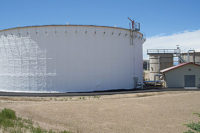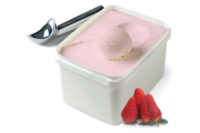Virtually all frozen desserts have a need for stabilization. Stabilizers extend the shelf life of products subjected to heat shock during distribution, sale and home storage. This functionality is related to the limitation of water mobility, which, unchecked, can negatively affect the growth of ice and other crystals in the product.
Although no stabilizer may be needed under certain composition and overrun considerations, (that is, products containing high fat, high solids and low overruns), classical hydrocolloids (primarily high-viscosity and/or gelling polysaccharides) have been used to stabilize ice cream. These include guar gum, locust bean gum, tara gum, cellulose gum and microcrystalline cellulose. In most instances they are used in combination to match the stabilization need to the specific products at issue at attractive cost. These type of hydrocolloids have been selected due to their ability at low use levels to manage viscosities of mixes and to immobilize water or otherwise interfere with ice crystal growth during heat shock.
The same water mobility control, but at a much lower net effect, has been assumed for more bulky ingredients, such as corn syrup solids (CSS), polydextrose (PDX) and maltodextrins (MDX). The explanation has been that their high molecular weight offers minor, but useful, water mobility influences in the unfrozen portion of the mix. The higher the average molecular weight and more complex the structure of the ingredient, the more control of water mobility is provided. Limits as to how much and what types of these ingredients that can be used are most often related to flavor (low sweetness, flavor masking, undesirable “corn syrup” flavor, etc.) and overstabilized (sticky or gummy) ice creams.
With current pricing of stabilizer ingredients on wild “mood swings” and the increasing pressure on pricing due to non-domestic sourcing, a new look at the utility of low-viscosity polysaccharides such as gum acacia could be of value in stabilizing ice cream. A similar consideration would apply to conventional stabilizer ingredients used at very low levels and to low-viscosity bulking agents such as MDX, modified MDX (e.g., digestion resistant MDX), PDX and the like.
In most instances, these polysaccharides have been used in frozen desserts as low-cost bulking agents and as materials that:
- help balance the freezing point depression effects of the smaller, more sweet carbohydrates (sucrose, fructose, glucose and select sugar alcohols)
- provide useful water immobilization functionality
- and/or help manage total sugars in no-sugar-added and sugar-free products.
It may now be theorized that under the influence of freeze concentration, these low-viscosity ingredients may — alone or in combination — offer significant water immobilization functionality after hardening, when about 80-85% of total water is frozen. Further, in such ultra-high concentrated solutions (up to 7-8 times that found in unfrozen mix), not only might these compounds manage water mobility, but also they might begin to physically and/or chemically interact with each other to further increase water mobility beyond what might be apparent or intuitive from their individual structure, composition and use rates. In some cases, these interactions may be irreversible so that the modified structure will remain and be functional even when the unfrozen portion is diluted by the melting of ice at higher temperatures.
Therefore, low-viscosity polysaccharides might offer resistance to heat shock beyond what would normally be predicted. The utility of managing such influences might become an important use of ultra-low freezing technologies where high amounts of water frozen can be paired with lower viscosities prior to packaging and ultimate hardening. This, in turn, would facilitate the flow of the unhardened ice cream through the freezing process and the addition of inclusions, then on to packaging. Once hardened, the water mobility functions of these low-viscosity polysaccharides would “kick-in” and stabilize the final product.
As always, costs, use rates, availability, labeling, regulatory limits, influences on flavor, body and texture, and other considerations need to be taken into account when formulating ice cream with these low-viscosity polysaccharides. However, if properly selected and used, lower-cost, domestically sourced and consumer friendly stabilizers might result. This, in turn, would help deliver smooth, creamy ice cream under the duress of distribution and sale. Perhaps they might even offer “clean labeling” opportunities in the process.
Bruce Tharp and Steven Young wrote “Tharp & Young On Ice Cream: An Encyclopedic Guide to Ice Cream Science & Technology,” available this fall from DesTech Publications, www.destechpub.com.
Find out more in Las Vegas
For more on the utility of low-viscosity polysaccharides to stabilize ice cream, attend the 31st edition of the “Tharp & Young On Ice Cream Technical Short Course, Workshops and Clinics,” Nov. 28-30 in Las Vegas. Go to www.onicecream.com, or call 610-975-4424 or 281-782-4536.




